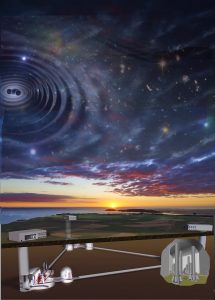Future Detectors
Next generation terrestrial detectors
The Einstein Telescope is a new infrastructure for detecting gravitational waves in Europe and can be seen as the successor of Virgo. This new observatory is being designed to be 10 times more sensitive than Virgo, aiming to detect nealy all the fusions of the black holes and neutron stars in the Universe.

ET will probably have 10 km long arms in a triangular configuration and will implement new technologies, perfected over the years thanks to the experience of Virgo, such as the active noise mitigation systems to reduce environmental perturbations. All of this will give Einstein Telescope a sensitivity much higher than that of its predecessors, therefore allowing it to explore the cosmos up to the up to the most remote eras of its evolution
The start of ET operation is planned by the end of the next decade.
The Einstein Telescope will have an US counterpart on the same timescale: Cosmic Explorer. It will also be a new infrastructure with 40 km-long arms, sharing the same science goals than ET.
Space missions
Detecting and studying GWs from much heavier sources (such as supermassive black holes) require to be sensitive to much lower frequencies (below the Hertz), something that is impossible for ground-based detectors which, in spite of their careful design and construction, are blinded by the residual seismic noise that their suspensions cannot filter out. The solution to this problem is to go to space: the LISA (Laser Interferometer Space Antenna) project is currently in preparation and its current launch date is around 2037. The LISA detector will be made of three spacecrafts, forming an equilateral triangle and located about 2.5 million kilometers apart. They will exchange laser beam which will sense along their pathlow-frequency changes in the spacetime due to GWs.
Other space projects, such as DECIGO or TianQin, are also under consideration. The distance between satellites would be smaller to cover the frequency gap between LISA and ground based laser interferometers.
Pulsar timing array
Pulsars are rotating compact stars emitting a radio wave signal at a very regular pace. They can be seen as cosmic clocks. By studying the arrival time of the radio pulses on Earth over several years, one can detect any perturbations due to passing ultra-low frequency GW. Several groups have joined their effort under the International Pulsar Timing Array collaboration with some scientific results already published albeit without claim of a direct detection.